
still need the previous edition?
![]() .Events .Moon .Planets .Major Events .Minor Planets, NEOs .Comets .Shooting Stars .Occultations .Sun .check more! (occultations observers are advised to check in 'Events', and to turn to such dedicated sites like the I.O.T.A). don't forget to check the weather! For the US: the NOAA . color codes: Wwd worldwide, UsA USA-Americas, EuA Europe-Africa, AsP Asia-Pacific, Chk Check for Your Zone. check the site's concept and the instructions of use
.Events .Moon .Planets .Major Events .Minor Planets, NEOs .Comets .Shooting Stars .Occultations .Sun .check more! (occultations observers are advised to check in 'Events', and to turn to such dedicated sites like the I.O.T.A). don't forget to check the weather! For the US: the NOAA . color codes: Wwd worldwide, UsA USA-Americas, EuA Europe-Africa, AsP Asia-Pacific, Chk Check for Your Zone. check the site's concept and the instructions of use
![]()
![]() Editor's Choice Fine Picture Archives
Editor's Choice Fine Picture Archives ![]() Editor's Choice Sky At
Editor's Choice Sky At ![]()
![]()
![]() Tech News
Tech News ![]() color codes: Wwd worldwide, UsA USA-Americas, EuA Europe-Africa, AsP Asia-Pacific, Chk Check for Your Zone. check the site's concept and the instructions of use
color codes: Wwd worldwide, UsA USA-Americas, EuA Europe-Africa, AsP Asia-Pacific, Chk Check for Your Zone. check the site's concept and the instructions of use
| Tweet |
.Events Seen All Month Long .Ephemerides Proper
(data from the former yearly ephemerides generator at Fred Espenak's NASA's eclipse website; miscellaneous data with the 'Astronomical Phenomena for The Year 2017,' a joint work by the United Kingdom Hydrographic Office and the U.S. Naval Observatory; to be found at the latter's site; all time UT except otherwise stated)
Wwd Venus is passing about Saturn in twilight Dec. 8-13 as both are evening stars in the northern hemisphere. A closest is reached about Dec. 11. Albeit the show is low southwest at about 20 degree of altitude, worth the visual and photographic observation! The show, higher, is also available at the Tropics or the southern hemisphere. Moon will also come to add
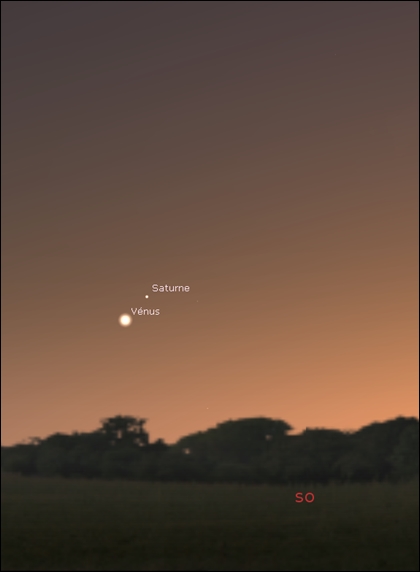 | Venus is reaching a closest to Saturn by Dec. 11 as it's moving in twilight! picture site 'Amateur Astronomy' based upon the Stellarium software |
Wwd The three stars of the Summer Triangle, that distinctive feature of the skies by summer, are seen, in the northern hemisphere only, like high evening stars West. Fine views! Also of interest is that Vega and Deneb, two of those three stars, are reappearing with dawn, like morning stars, northeast!
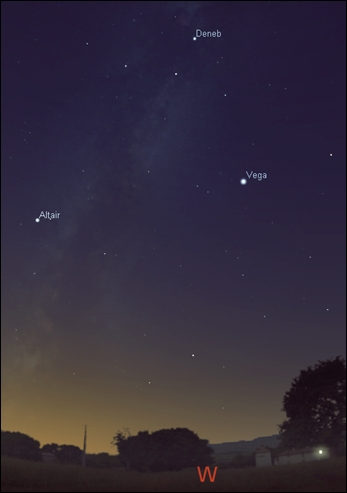 | The Summer Triangle, in the northern hemisphere, is seen by twilight! picture site 'Amateur Astronomy' based upon Stellarium |
Wwd A set of fine constellations embedded into the Milky Way is seen South by dawn at the Tropics. Fine views!
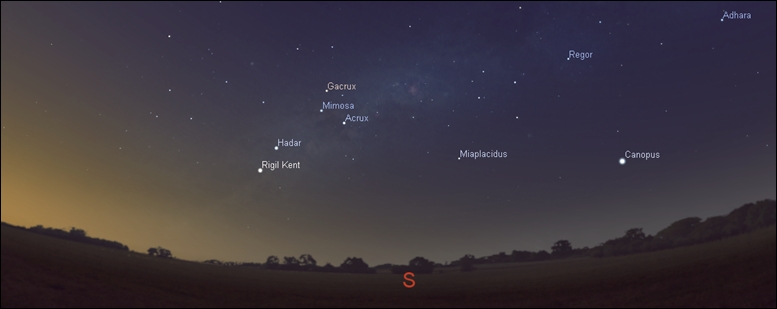 | Fine constellations are seen South, by dawn, at the Tropics, embedded into the Milky Way! picture site 'Amateur Astronomy' based upon Stellarium |
5 Wwd Moon is at its apogee at 04:09 UT (distances non available)
Wwd 7 The Geminids, one among the most active shooting stars showers in the year, usually begin to be active today as they are until next Dec. 17. They usually are peaking on Dec. 13-14 more at the date of the peak
10 UsA Moon, by all latitudes, two days before full, is seen close to Aldebaran, the bright star to constellation Taurus, the Bull
11 EuA AsP Moon, at all latitudes, one day before full, is seen close to Aldebaran, the bright star to constellation Taurus, the Bull
13 (1) Wwd The Geminids usually are peaking on Dec. 13-14 more back
13 (2) Wwd Moon is at a ascending node at 14:15 UT as it also reaches a northernmost declination at 20:57 UT
18 Wwd Moon is at its perigee at 20:30 UT (distances non available)
22 (1) Wwd It is the winter solstice today, by 04:19. It's winter North, and summer South! check more details about Earth's seasons with our tutorial Seasons
22 (2) Wwd Tomorrow morning by dawn, by all latitudes, last crescent is seen close to Mars. Fine!
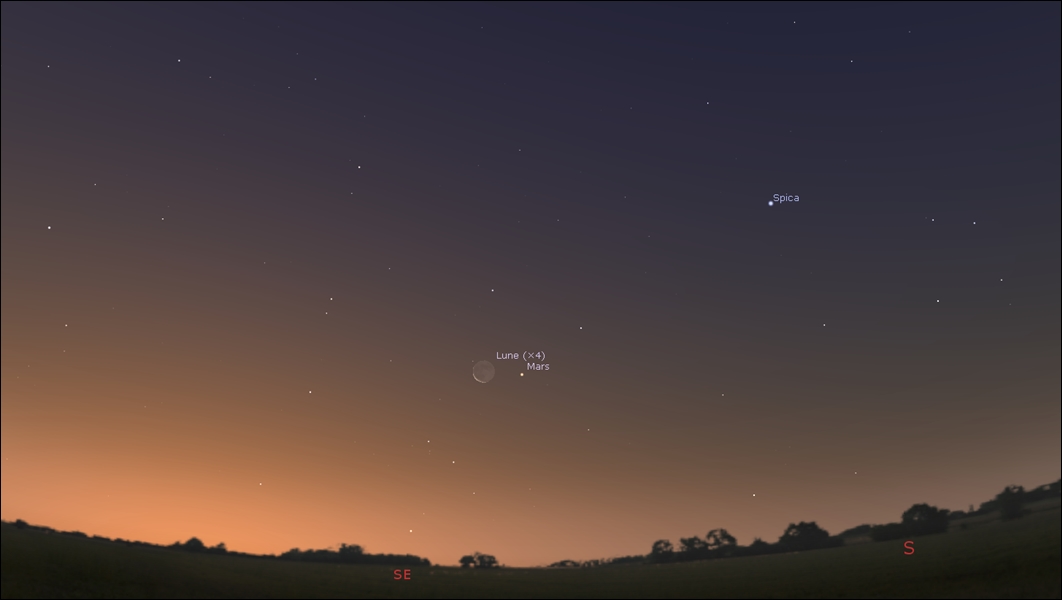 | Moon close to Mars in the morning sky! picture site 'Amateur Astronomy' based upon the Stellarium software |
26 (1) Wwd The last major astronomical event in 2019 is occurring today, the December 26th, 2019 annular eclipse! check more
26 (2) Wwd Moon is at a descending node at 13:01 UT as it also reaches a southernmost declination at 20:11 UT
27 (1) Wwd One-day old Moon, at all latitudes, is close to Saturn in twilight. Albeit low at some locations, worth the visual and photographic observation!
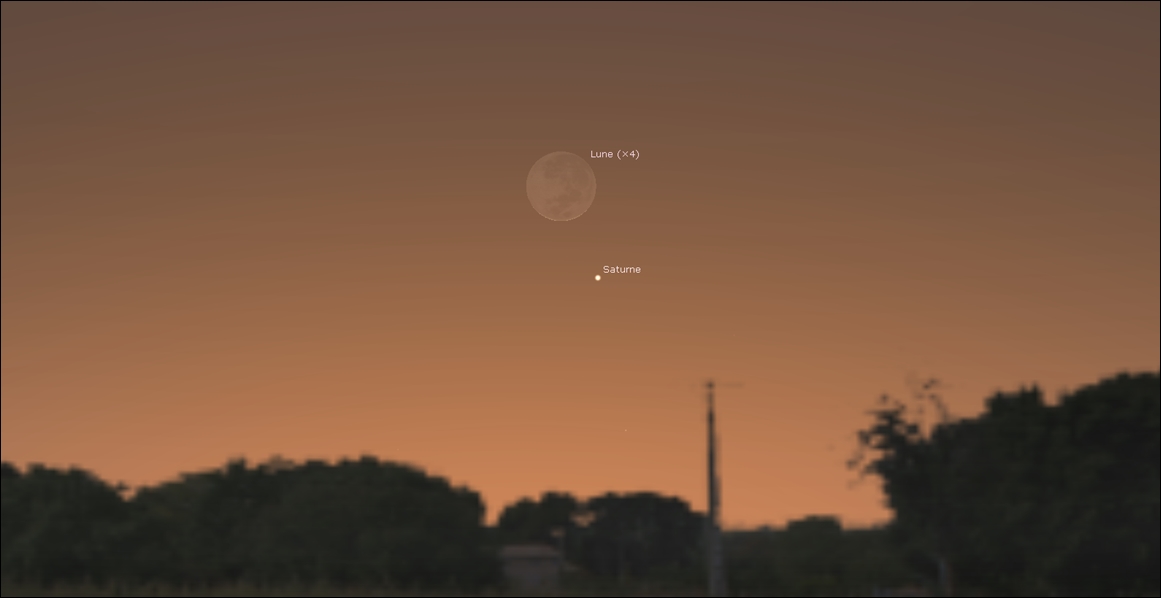 | One-day old Moon is close to Saturn by twilight! Fine! picture site 'Amateur Astronomy' based upon the Stellarium software |
27 (2) Wwd There is a occultation of Pluto today by Moon! check more at Occultations; check more too at such sites like "The International Occultation Timing Association" (I.O.T.A.)
28 UsA EuA Very first crescent, by all latitudes, is seen by Venus in twilight. Worth the visual and photographic observation!
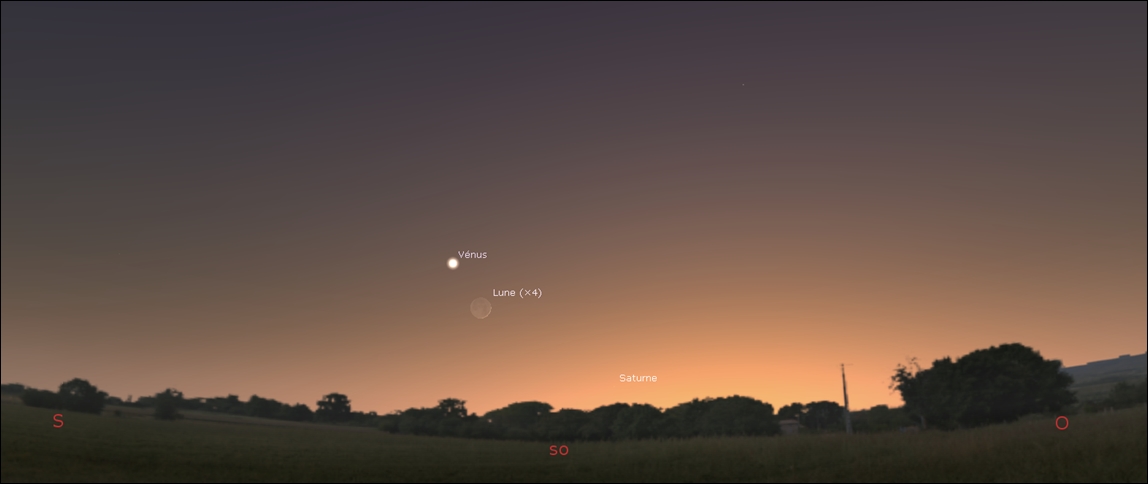 | Very first crescent close to Venus by twilight! Fine! picture site 'Amateur Astronomy' based upon the Stellarium software |
29 (1) AsP Very first crescent, at all latitudes, is seen by Venus in twilight. Worth the visual and photographic observation!
29 (2) Wwd There is a occultation of Venus today by Moon! check more at Occultations; check more too at such sites like "The International Occultation Timing Association" (I.O.T.A.)
Occultations observers are advised to turn to such dedicated sites like the I.O.T.A as they may also check below at our Occultation section
First Quarter is on December 4th, at 06:58 UT
Full Moon is on December 12th, at 05:12 UT
Last Quarter is on December 19th, at 04:57 UT
New Moon is on December 26th, at 05:13 UT
(source: ephemeris generator at Fred Espenak's NASA's eclipse website)
for what a remarkable configuration of a planet is, check our tutorial 'Planets Apparent Motion'
Mercury is reaching no remarkable configuration in December 2019. The swift planet is too low like a morning star, and then tending to the Sun, to be available for observation worldwide. At the Tropics only or even in the northern hemisphere, Mercury provides for show by early December. The show is weak at the Tropics as it may be interesting in the northern hemisphere
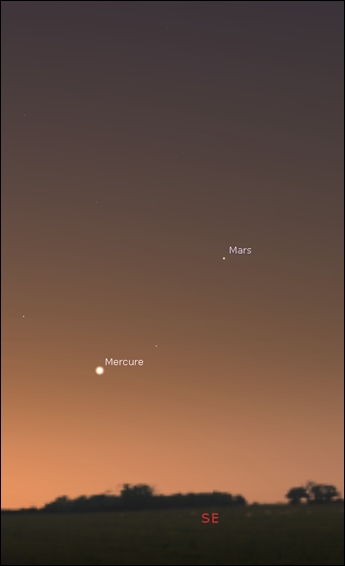 | Mercury reachable by early December in some locations! picture site 'Amateur Astronomy' based upon the Stellarium software |
Venus is now a low evening star in the northern hemisphere, southwest, higher at the Tropics or the southern hemisphere
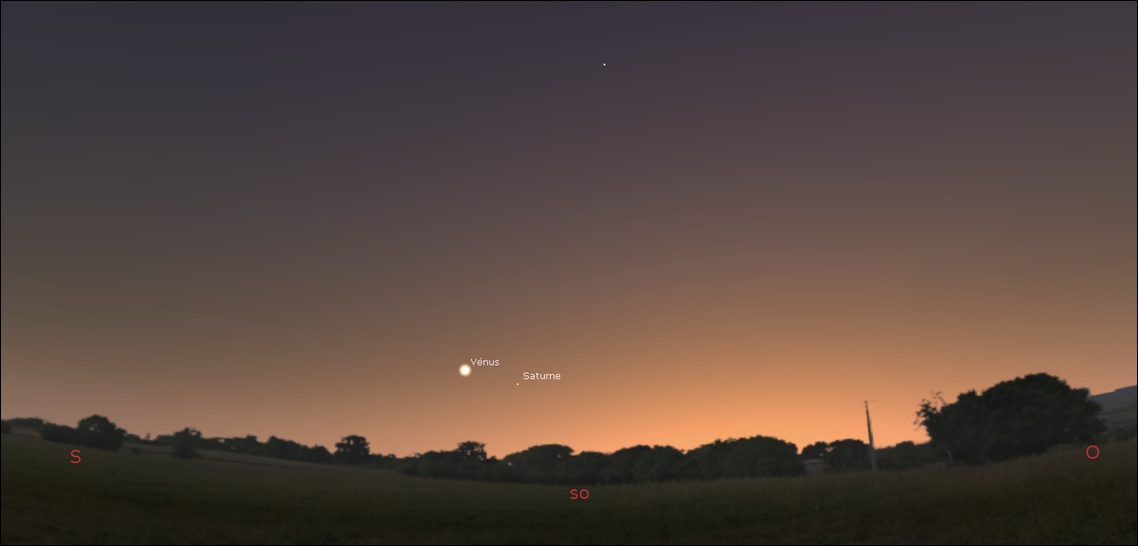 | Venus (and Saturn) is a evening star! picture site 'Amateur Astronomy' based upon the Stellarium software |
Mars is now a morning star in the northern hemisphere by southeast. It's higher past East at the Tropics, or about like in the northern hemisphere in the southern
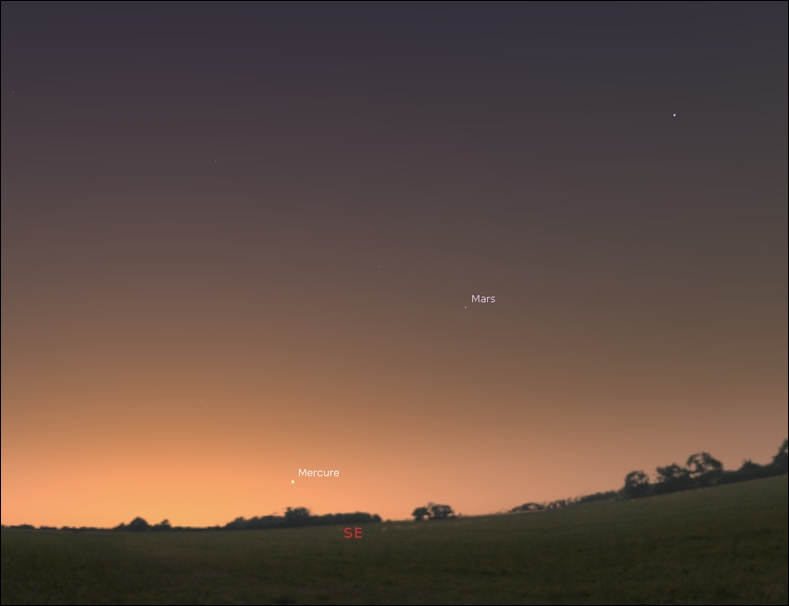 | Mars is now a morning star! picture site 'Amateur Astronomy' based upon the Stellarium software |
Jupiter is reaching a conjunction on December 27th by 18:06. Jupiter is seen nowhere worldwide
Saturn is now a low evening star in the northern hemisphere, southwest. It's higher at the Tropics or the southern hemisphere. Following a ring aperture maximum, rings now are closing
Uranus keeps high soutwest, and well observable, in the northern hemisphere by 10:30 p.m. local. High too at the Tropics about northwest, and high too about North in the southern hemisphere
Neptune albeit now low between southwest and West in the northern hemisphere by 10:30 p.m. local time keeps observable due to a early twilight. The same at the Tropics and better observable still! Neptune in the southern hemisphere doesn't benefit from a early twilight, as it's still high, about West, by 10:30 p.m. local time, allowing for observation
Pluto is now too low and no conditions allow for observation worldwide(according to the International Astronomical Union (IAU) since 2006, Pluto is not considered a planet anymore, but categorized like a dwarf planet instead along with Ceres, Eris, Makemake, and Haumea, and the prototype of a new category of 'trans-Neptunian', 'Pluto-class' objects)
The Annular Solar Eclipse of December 26th, 2019
The last solar eclipse in 2019 -- and the last major astronomical event this year -- is a annular eclipse occurring on December 26th, 2019. A annular solar eclipse is when a ring of Sun keeps being seen at totality, surrounding the Moon's disk. It is occurring from northern Saudi Arabia to the western Pacific ocean. Like usual, a partial solar eclipse is seen either side of the line of centrality. check our page dedicated to that event
| CAUTION! OBSERVING A SUN ECLIPSE IS DANGEROUS AND MAY CAUSE IRREVERSIBLE EYE DAMAGE, UP TO BLINDNESS, ANNULAR AND PARTIAL ECLIPSES INCLUDED! Observing a Sun eclipse necessitates DEDICATED SAFE TECHNIQUES! |
Minor planets are those biggest asteroids in the Asteroid Belt which may be easily observed by amateurs from the Earth, namely Ceres, Pallas, Juno, and Vesta (due to the new categorization by the International Astronomical Union (IAU) by 2006, Ceres belongs to the 5 dwarf planets in the solar system with Pluto, Eris, Makemake, and Haumea). check data and charts at our section Minor Planets on the yearly Calendar page as our tutorial 'Asteroids and Asteroid Hunting' is of help too. Any remarkable event linked to a minor planet may have a notice here below
Some small asteroids dubbed Near-Earth Objects (NEOs) are regularly making close approaches at Earth. People interested in such close approaches may obtain recent and upcoming data at NASA (JPL) site Center for Near Earth Object Studies (CNEOS) (their section "Close Approaches"). Miscellaneous data are available. For further observational purposes, check at their ephemeris Generator (via Tools/Neo DB Query)
. For more about NEOs see tutorial "
Once every time, the solar system treats us with a remarkable comet, a eery view spanning up to thirty degrees of sky! Most of the time however comets are the domain of dedicated observers as mostly weak and, at the most, hovering at the limit of the naked-eye visibility. A good site to get information about current such comets is the British Astronomical Association Comet Section page or also the Weekly Information about Bright Comets page (which often points to comets close to the visual magnitude). Our 'Comets and Comet Hunting' tutorial will also be helpful. Remarkable comets otherwise usually will be presented below!
->note: shooting stars afficionados will be aware of checking Moon at the dates of the showers
for more about the meteor showers of this month, for possible other meteor showers for this month, and for more about shooting stars, generally, see our tutorial "Shooting Stars"
Each month, Moon occults some relatively bright stars, that is the Moon, beginning either with its bright or its dark visible face, is passing in front of a star. This is called an occultation. The Pleiades, on the other hand, due to their position near the eclipic, are often occulted by Moon too. Some planets, at last, along the year, may be occulted by Moon or they themselves, or their satellites, may be seen too occulting a star. The asteroids too may occult stars. Yearly lists of such phenomenons are to be found at Sky & Telescope/SkyTonight.com, either in their newsstand issues or at their site, as a list of occultations of most brilliant stars, the planets and the Pleiades are available at the I.O.T.A site (I.O.T.A. stands for "The International Occultation Timing Association"). Most notable occultations are signaled below
The configuration of Moon makes 2019 a great year of occultations of planets and minor planets by the Moon as, amazingly none of the bright stars usually occulted by Moon, like Aldebaran, Antares, Regulus or Spica, will be!
Pluto back is occulted by Moon on Dec. 27th, 2019 by 15:00 UT! The show is available for S. South America, South Georgia, parts of Antarctica, Kerguelen Is., S. tip of Africa, S. Madagascar. check more at such sites like "The International Occultation Timing Association" (I.O.T.A.)
Venus back is occulted by Moon on Dec. 29th, 2018 by 02:00 UT! The show is available for Antarctica, S. tip of South America. check more at such sites like "The International Occultation Timing Association" (I.O.T.A.)
check on this site for more about occultations, theoretically
| CAUTION! OBSERVING THE SUN IS DANGEROUS AND REQUIRES DEDICATED SAFE TECHNIQUES! |